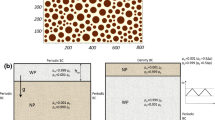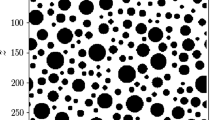Abstract
A hierarchical computational protocol is introduced to investigate the role of interfacial and wetting properties to the fluid displacement in hydrophilic pore network models (PNMs). Based on the combination of molecular dynamics (MD) and lattice Boltzmann method (LBM) simulations at both nano- and microscales, we study the role of dispersed functionalized \(\hbox {SiO}_{2}\) nanoparticles (NP) in brine to the oil displacement process in a clay (montmorillonite—MMT) pore structure. Our MD calculations indicate that dispersion of NP, with different hydrophilic properties, in brine solution reduces the interfacial tension between oil and brine, followed by an increase in the contact angle. The lowest interfacial tension and highest contact angle are for the hydrophilic NP functionalized with polyethylene glycol groups. By mapping the properties obtained from MD into LBM simulation parameters, we explore the oil displacement process in hydrophilic PNMs at the microscale. For all systems, the Young–Laplace filling rules are obeyed and, due to the finger formation, the displacement efficiency decreases as the capillary number increases. It was observed that, with the inclusion of NP, a reduction in interfacial tension associated with an increase in the contact angle may enhance the oil displacement process in hydrophilic pore systems at the microscale. The proposed computational protocol can be a versatile tool to explore the potentialities of chemical additives, such as NP, for the oil recovery process and investigate the effects of interfacial tension and wetting properties on the fluid behavior at both nano- and microscales.









Similar content being viewed by others
References
Alejandre J, Chapela GA, Bresme F, Hansen JP (2009) The short range anion-H interaction is the driving force for crystal formation of ions in water. J Chem Phys 130:174505-1-10
Andersen HC (1980) Molecular dynamics simulations at constant pressure and/or temperature. J Chem Phys 72:2384–2393
Amott E (1956) Observations relating to the wettability of porous rock. Trans AIME 216:156–162
Benjamin I (1997) Molecular structure and dynamics at liquid-liquid interfaces. Ann Rev Phys Chem 48:407–451
Berthelot D (1898) Compte rendus hebdomadaires des seances de lacademie des sciences. Acad des Sci Bachelier Paris 126:1703–1706
Biben T, Joly L (2008) Wetting on nanorough surfaces. Phys Rev Lett 100:186103-1–4
Blunt M, King MJ (1992) Simulation and theory of two-phase flow in porous media. Phys Rev A 46:7680
Bonn PD, Eggers J, Indekeu J, Meunier J, Rolley E (2009) Wetting and spreading. Rev Mod Phys 81:739–805
Boukellal H, Selimović S, Jia Y, Cristobalb G, Fraden S (2009) Simple, robust storage of drops and fluids in a microfluidic device. Lab Chip 9:331–338
Brindley GW, Brown G (1980) Crystal structures of clay minerals and their X-ray identification. Mineralogical Society, London
Brooks BR et al (2009) CHARMM: the biomolecular simulation program. J Comp Chem 30:1545–1615
Buckley JS, Fan T (2007) Crude oil/brine interfacial tensions. Petrophysics 48:175–185
Buckley JS (1991) Multiphase displacements in micromodels. In: Interfacial phenomena in petroleum recovery. Marcel Dekker Inc, New York, pp 157–189
Chandler D (2007) Physical chemistry: oil on troubled waters. Nature 445:831–832
Chapmana EM, Yanga J, Crawshawa JP, Boek ES (2013) Pore scale models for imbibition of \(\text{ CO }_{2}\) analogue fluids in etched micro-fluidic junctions from micro-model experiments and direct LBM flow calculations. Energy Procedia 37:3680–3686
Chattoraj DK, Birdi KS (1984) Adsorption and the Gibbs surface excess. Plenum Publishing Company, New York
Chen S, Doolen GD (1998) Lattice Boltzmann method for fluid flows. Ann Rev Fluid Mech 30:329–364
Chu EC, Aksimentiev A, Schulten K (2006) Water-silica force field for simulating nanodevices. J Phys Chem B 110:21497–21508
Coon ET, Porter ML, Kang Q (2014) Taxila LBM: a parallel, modular lattice Boltzmann framework for simulating pore-scale flow in porous media. Comput Geosci 18:17–27. https://software.lanl.gov/taxila
Cygan RT, Liang JJ, Kalinichev AG (2004) Molecular models of hydroxide, oxyhydroxide, and clay phases and the development of a general force field. J Phys Chem B 108:1255–1266
de Lara LS, Michelon MF, Miranda CR (2012a) Molecular dynamics studies of fluid/oil interfaces for improved oil recovery processes. J Phys Chem B 116:14667–14676
de Lara LS, Michelon MF, Metin CO, Nguyen QP, Miranda CR (2012b) Interface tension of silica hydroxylated nanoparticle with brine: a combined experimental and molecular dynamics study. J Chem Phys 136:164702-1-8
de Serio M, Mohapatra H, Zenobi R, Deckert V (2006) Investigation of the liquid–liquid interface with high spatial resolution using near-field Raman spectroscopy. Chem Phys Lett 417:452–456
Du Q, Freysz E, Shen YR (1994) Surface vibrational spectroscopic studies of hydrogen bonding and hydrophobicity. Science 264:826–828
Dullien FAL (1992) Fluid transport and pore structure. Academic Press, San Diego
Evans DJ, Morriss GP (1990) Statistical Mechanics of Non Equilibrium Liquids. Academic Press, London 1990, Theoretical Chemistry Monograph Series
Gavryushov S (2007) Dielectric saturation of the ion hydration shell and interaction between two double helices of DNA in mono- and multivalent electrolyte Solutions: foundations of the \(\epsilon\)-modified Poisson-Boltzmann theory. J Phys Chem B 111:5264–5276
Ghoufi A, Goujon F, Lachet V, Malfreyt P (2008) Surface tension of water and acid gases from Monte Carlo simulations. J Chem Phys 128:154716–154731
Green MS (1954) Markoff random processes and the statistical mechanics of time-dependent phenomena. J Chem Phys 22:398–413
He X, Zou Q, Luo LS, Dembo M (1997) Analytic solutions of simple flows and analysis of nonslip boundary conditions for the lattice Boltzmann BGK model. J Stat Phys 87:115–136
Hockney E (1989) Computer simulation using particles. Adam Hilger, New York
Hoover WG (1985) Canonical dynamics: equilibrium phase-space distributions. Phys Rev A 31:1695–1697
Hore DK, Walker DS, Richmond GL (2008) Water at hydrophobic surfaces: when weaker is better. J Am Chem Soc 130:1800–1801
Jang SS, Lin ST, Maiti PK, Blanco M, Goddard WAJ, Shuler P, Tang Y (2004) Molecular dynamics study of a surfactant-mediated decane-water interface: effect of molecular architecture of alkyl benzene sulfonate. J Phys Chem B 108:12130–12140
Jungwirth P, Finlayson-Pitts BJ, Tobias D (2006) Introduction: structure and chemistry at aqueous interfaces. J Chem Rev 106:1137–1139
Koplik J, Banavar JR (1995) Continuum deductions from molecular hydrodynamics. Annu Rev Fluid Mech 27:257–292
Kubo R (1957) Statistical-mechanical theory of irreversible processes. J Phys Soc Jpn 12:570–586
Kunieda M, Nakaoka K, Liang Y, Miranda CR, Ueda A, Takahashi S, Okabe H, Matsuoka T (2010) Self-accumulation of aromatics at the oil-water interface through weak hydrogen bonding. J Am Chem Soc 132:18281–18286
Lambert J, Hergenröder R, Suter D, Deckert V (2009) Probing liquidliquid interfaces with spatially resolved NMR spectroscopy. Angew Chem Int Ed 48:6343–6345
Lenormand R, Zarcone C, Sarr A (1983) Mechanisms of the displacement of one fluid by another in a network of capillary ducts. J Fluid Mech 135:337–353
Li Y, Xu J, Li D (2010) Molecular dynamics simulation of nanoscale liquid flows. Microfluid Nanofluid 9:1011–1031
Lorentz HA (1881) Ueber die anwendung des satzes vom virial in der kinetischen theorie der gase. Ann der Phys 248:127–136
Makimura D, Metin C, Kabashima T, Matsuoka T, Nguyen QP, Miranda CR (2010) Combined modeling and experimental studies of hydroxylated silica nanoparticles. J Mater Sci 45:5084–5088
McElfresh PM, Wood M, Ector D (2012) Stabilizing nano particle dispersions in high salinity, high temperature downhole environments. SPE 154758-MS
Metin CO, Rankin KM, Nguyen QP (2014) Phase behavior and rheological characterization of silica nanoparticle gel. Appl Nanosci 4:93–101
Michael D, Benjamin I (1995) Solute orientational dynamics and surface roughness of water/hydrocarbon interfaces. J Phys Chem 99:1530–1536
Miranda CR, de Lara LS, Tonetto BC (2012) Stability and mobility of functionalized silica nanoparticles for enhanced oil recovery applications. SPE 157033-MS
Mitrinovic DM, Tikhonov AM, Li M, Huang ZQ, Schlossman ML (2000) Noncapillary-wave structure at the water-alkane interface. Phys Rev Lett 85(3):582–585
Murray DK (2010) Differentiating and characterizing geminal silanols in silicas by \(^29\)Si NMR spectroscopy. J Colloid Interface Sci 352:163–170
Navrotsky A (2003) Zeolites: ordered, disordered, collapsed. Nat Mater 2:571–572
Nomoto T, Onishi H (2007) Fourth-order coherent raman spectroscopy in a time domain: applications to buried interfaces. PCCP 9:5515–5521
Nosé S (1984) A unified formulation of the constant temperature molecular dynamics methods. J Chem Phys 81:511–519
Petersen KS, Christensen PL (2007) Phase behavior of petroleum reservoir fluids. CRC, Boca Raton
Plimpton S (1995) Fast parallel algorithms for short-range molecular dynamics. J Comput Phys 117:1-19. http://lammps.sandia.gov
Porter ML, Coon ET, Kang Q, Moulton JD, Carey JW (2012) Multicomponent interparticle-potential lattice Boltzmann model for fluids with large viscosity ratios. Phys Rev E 86:036701-1–036701-8
Rigo VA, de Lara LS, Miranda CR (2014) Energetics of formation and hydration of functionalized silica nanoparticles: an atomistic computational study. App Surf Sci 292:742–749
Scatena LF, Brown MG, Richmond GL (2001) Water at hydrophobic surfaces: weak hydrogen bonding and strong orientation effects. Science 292:908–912
Sondjaja HR, Hatton TA, Tam KC (2008) Self-assembly of poly(ethylene oxide)-block-poly(acrylic acid) induced by \(\text{ CaCl }_{2}\): mechanistic study. Langmuir 24:8501–8506
Song J, Choi M (2002) Stability of elongated and compact types of structures in \(\text{ SiO }_{2}\) nanoparticles. Phys Rev B 65:241302-1–241302-4
Succi S (2001) The lattice Boltzmann equation. Oxford University Press, Oxford
Sukop MC, Thorne DT Jr (2006) Lattice Boltzmann modeling. Springer, Delft
Talu O, Myers AL (2001) Molecular simulation of adsorption: Gibbs dividing surface and comparison with experiment. AIChE J 47:1160–1168
Tchelepi HA, Orr FM Jr, Rakotomalala N, Salin D, Woumeni R (1993) Dispersion, permeability heterogeneity and viscous fingering: acoustic experimental observations and particle tracking simulations. Phys Fluids 5:1558–1574
Thompson AP, Plimpton SJ, Mattson W (2009) General formulation of pressure and stress tensor for arbitrary many-body interaction potentials under periodic boundary conditions. J Chem Phys 131:154107–154112
Ushikubo FY, Birribilli FS, Oliveira DRB, Cunha RL (2014) Y- and T-junction microfluidic devices: effect of fluids and interface properties and operating conditions. Microfluid Nanofluid 17:711–720
Varnik F, Baschnagel J, Binder K (2000) Molecular dynamics results on the pressure tensor of polymer films. J Chem Phys 113:4444–4453
Wasan DT, Nikolov AD (2003) Spreading of nanofluids on solids. Nature 423:156–159
Wolf-Gladrow DA (2000) Lattice-gas cellular automata and lattice Boltzmann models. Springer, Berlin
Wörner M (2012) Numerical modeling of multiphase flows in microfluidics and micro process engineering: a review of methods and applications. Microfluid Nanofluid 12:841–886
Zhang L, Zhang Z, Wang P (2012) Smart surfaces with switchable superoleophilicity and superoleophobicity in aqueous media: toward controllable oil/water separation. NPG Asia Mater 4:e8
Zhang J (2011) Lattice Boltzmann method for microfluidics: models and applications. Microfluid Nanofluid 10:1–28
Zhang T, Davidson A, Bryant SL, Huh C (2010) Nanoparticle-stabilized emulsions for applications in enhanced oil recovery. SPE 129885-MS
Zhang Y, Feller SE, Brooks BR, Pastor RW (1995) Computer simulation of liquid/liquid interfaces. I. theory and application to octane/water. J Chem Phys 103:10252–10266
Acknowledgments
This work was supported by the Advanced Energy Consortium: http://www.beg.utexas.edu/aec/ Member companies include BP America Inc., BG Group, Petrobras, Repsol, Schlumberger, Statoil, Shell, and Total. The authors also acknowledge the financial support provided by the Brazilian agencies CAPES, CNPq, and FAPESP and the computational support from CENAPAD/SP and UFABC.
Author information
Authors and Affiliations
Corresponding author
Electronic supplementary material
Below is the link to the electronic supplementary material.
Rights and permissions
About this article
Cite this article
Pereira, A.O., Lara, L.S. & Miranda, C.R. Combining molecular dynamics and lattice Boltzmann simulations: a hierarchical computational protocol for microfluidics. Microfluid Nanofluid 20, 36 (2016). https://doi.org/10.1007/s10404-016-1704-7
Received:
Accepted:
Published:
DOI: https://doi.org/10.1007/s10404-016-1704-7




